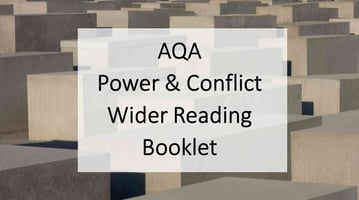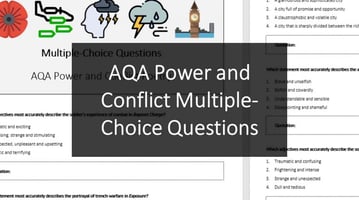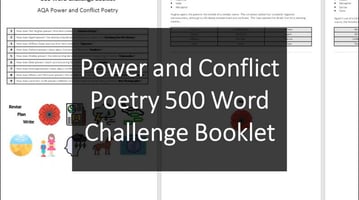Click on the link above to access a booklet that contains wider reading articles connected to the...
Snapshot Revision Notes on the AQA Power and Conflict Poems
Click on the link above to access a Word document with the revision notes on the AQA Power and Conflict Poems and here to access some wider reading QR codes.
Ozymandias, by Percy Bysshe Shelley (1818)
- The once ‘vast’ statue of Ozymandias is now just a ‘colossal wreck’
- The ruins remind us that power, even for a self-proclaimed ‘King of Kings’, is transient
- In one sense, the words on the pedestal are ironic because there is nothing left to make others ‘despair’
- However, in another, they provide a warning that all rulers will eventually share the same fate
- The most striking image is the ‘boundless and bare’ desert, which hints at the enduring power of the natural world
London, by William Blake (1792)
- The city of London is characterised by images of claustrophobia, oppression and violence
- The inhabitants are miserable and their faces are marked with ‘weakness’ and ‘woe’
- The sounds of the city reflect this sense of misery: the infants ‘cry’, the soldiers ‘sigh’ and the harlots ‘curse’
- The ‘blood’ on the palace walls hints at the possibility of a revolution (like the one in France that began in 1789)
- Blake presents London as existing in a state of moral, physical and political turmoil
Extract from The Prelude, by William Wordsworth (1799)
- The speaker of the poem (probably Wordsworth himself) embarks on journey, both literally and metaphorically
- At first, the speaker is struck by the beauty of the ‘glittering’ and ‘sparkling light’ on the lake
- However, a contrast soon emerges between the ‘little boat’ and the ‘huge peak’
- The landscape becomes threatening and the speaker is soon in a ‘grave’ and ‘serious’ mood
- The speaker seems both troubled and fascinated by the sensation of feeling so insignificant
My Last Duchess, by Robert Browning (1842)
- The Duke’s monologue is initially characterised by overt gestures of flattery and politeness
- However, it soon becomes clear that he is possessive and demanding
- The syntax of the monologue becomes increasingly fragmented as the focus shifts to the Duchess’s behaviour
- The Duke’s admits that he ‘gave commands’ to stop her ‘smiles’, which implies that he ordered her murder
- The final image of Neptune ‘taming a sea-horse’ reflects the Duke’s desire to control those around him
The Charge of the Light Brigade, by Alfred Lord Tennyson (1854)
- Tennyson praises the heroism of the cavalrymen (i.e. the Light Brigade) who fought in the Battle of Balaklava
- He highlights that they were vastly outnumbered as they rode ‘into the Valley of Death’
- The reference to the ‘blunder’d’ command suggests a disastrous miscommunication
- The distinctive rhythm of the poem reflects the powerful, decisive galloping of the horses
- The structure follows the dramatic movement of the cavalrymen as they are ‘stormed at with shot and shell’
Exposure, by Wilfred Owen (1918)
- Owen describes the physical and mental trauma caused by frontline fighting as he and others experienced it
- The poem begins with the anticipation of conflict as the silence is disturbed by ‘successive flights of bullets’
- The freezing temperatures are presented as being just as deadly as the enemy soldiers
- Owen contrasts the ‘iced winds’ and ‘pale flakes’ with the ‘dark-red jewels’ of the fires at home
- The temporary shift to the third-person perspective conveys the impression of being totally lost in thought
Storm on the Island, by Seamus Heaney (1966)
- The poem opens with a collective statement of intent from the islanders to endure the coming storm
- Heaney uses military metaphors to convey its power – ‘blast’, ‘pummels’, ‘salvo’, ‘bombarded’
- The weather is presented as a formidable, dangerous and unpredictable force
- The landscape of the island is sparse and exposed, but the community have adapted to survive
- The poem is perhaps an allegory for the on-going political troubles in Northern Ireland that began in the 1960s
Bayonet Charge, by Ted Hughes (1957)
- Hughes immediately places the reader on the frontline in a scene that is characterised by chaos and confusion
- The intensity of the imagery in the first stanza emphasises the violent reality of combat
- The imagery then takes on a hallucinatory quality as the soldier struggles to make sense of the situation he is in
- The movements of the solider are clumsy and desperate – ‘stumbling’, ‘lugged’, ‘plunged’
- Faced with such horrors, the soldier loses his ‘human dignity’ as fear and panic overwhelm him
Remains, by Simon Armitage (2008)
- The title of the poem refers to both the literal remains of the looter and the trauma that clearly still remains
- The speaker alludes to ‘another occasion’ at the start of the poem, which implies acts of violence are common
- The brutality of the shooting contrasts with the speaker’s casual narration of the details
- The looter’s body is ‘carted off in the back of the lorry’ and disposed of unceremoniously
- The ‘bloody hands’ are an allusion to Macbeth and help to convey the speaker’s enduring feelings of guilt
Poppies, by Jane Weir (2005)
- Poppies are a universal symbol of remembrance and a reminder to the speaker of the risks her son will take
- Weir’s use of enjambment helps to create the impression of an open and emotionally complex inner monologue
- The ‘blackthorns’ metaphor used to describe the hair of the speaker’s son has connotations of religious sacrifice
- In contrast, the ‘treasure chest’ simile emphasises the great sense of adventure that awaits him
- The speaker continues to feel conflicted, but ultimately accepts the inevitability of her son’s departure
War Photographer, by Carol Ann Duffy (1985)
- The red light in the darkroom that ‘softly glows’ connotes blood and mortality, and creates a sombre tone
- ‘All flesh is grass’ is a reference from the Bible that emphasises the fragile and transient nature of human life
- Duffy creates a contrast between the safety of rural England and the ‘hundred agonies’ suffered by those abroad
- The close focus on the ‘stranger’ and his ‘wife’ provide a vivid and disturbing insight into the effects of war
- Duffy challenges our typically indifferent, desensitised responses to media coverage of global conflicts
Tissue, by Imtiaz Dharker (2006)
- The poem opens with a vibrant and beautiful image of ‘light’ that conveys a sense of optimism for the future
- As the poem progresses, light is described different ways – it ‘shines’, it is ‘luminous’ and there is ‘daylight’
- Light has strong symbolic significance: it is associated with life and growth, and also truth (think: enlightened)
- It ‘shines through’ the borderlines of maps and is able to ‘break through capitals and monoliths’
- In the same way that light changes, so does paper and ‘living tissue’, and this process of transformation is positive
The Emigrée, by Carol Rumens (1993)
- The speaker of the poem appears to be in exile whilst ‘tyrants’ run the country
- Contrasts between light and darkness are established to emphasise positive and negative perspectives
- The speaker’s memories are vividly associated with sunlight and colour
- The speaker’s native language has been ‘banned’, but it remains unforgotten
- The personification of ‘my city’ highlights the intense emotional connection felt by the speaker
Checking Out Me History, by John Agard (2005)
- The poem opens with a contrast between ‘Dem’ (the educational establishment) and ‘me’ (the speaker)
- The metaphor of a ‘bandage’ is used to emphasise the intentional denial of cultural and historical knowledge
- The speaker argues that the Eurocentric historical narratives taught in schools exclude more global perspectives
- The speaker combines anger with an emphatic celebration of great historical figures like Toussaint L’Ouverture
- The rejection of Standard English and the use of free verse help to create a powerfully authentic voice
Kamikaze, by Beatrice Garland (2013)
- The samurai sword evokes the concepts of honour and loyalty
- The pilot, as he looks down from his plane, is struck by the beauty and vitality of the natural world
- The imagery is characterised by vibrant colours and dynamic movements – ‘flashing’, ‘silver’, ‘swivelled’
- In contrast, the tuna is ‘dark’ and ‘dangerous’ and is perhaps representative of Emperor Hirohito
- The consequences of the pilot’s decision to fly back are severe, but the speaker avoids making judgements
Hope the stuff’s helpful –
Doug
Here are some Amazon links to revision guides that are commonly used by students:
GCSE English AQA Poetry Guide – Power & Conflict Anthology
Power and Conflict: GCSE Revision Guide and Practice Book for AQA English Literature
GCSE English: AQA Anthology of Poetry Power and Conflict: A Study and Revision Guide
AQA Poetry Anthology Power and Conflict Revision Guide: Ideal for home learning, 2022 and 2023 exams


.jpg?width=50&name=douglas-wise%20(2).jpg)



